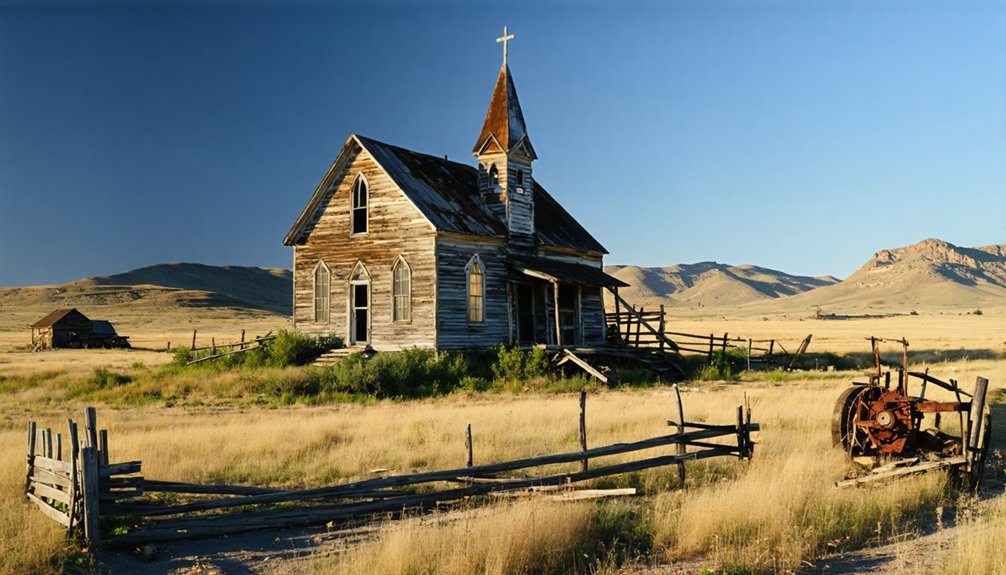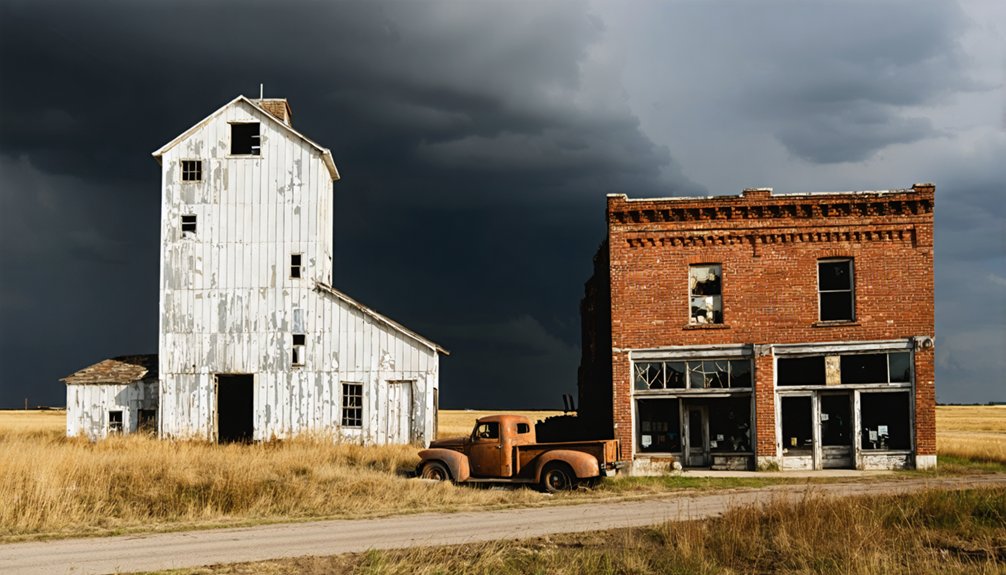You’ll find Arpan’s ghost town remnants in South Dakota’s Butte County, where this frontier settlement sprang to life in 1910. The town flourished briefly as a mining and railroad hub, anchored by its strategic T-shaped layout around the depot, with general stores and trading posts serving the Black Hills region. While its post office opened in 1911 marking community growth, today Arpan stands as a testament to the boom-and-bust cycles that shaped America’s western frontier. Its weathered structures hold countless untold stories.
Key Takeaways
- Established in 1910 in Butte County, South Dakota, Arpan was named after a prominent local family and developed around railroad operations.
- The town’s prosperity centered on its railroad depot, serving as a supply hub with general stores, grain elevators, and trading posts.
- Mining operations in the Black Hills region, including gold, silver, and copper deposits, significantly influenced Arpan’s early development.
- Post-World War II economic changes led to population decline, eventually transforming Arpan into its current ghost town status.
- Deteriorating buildings and structures remain visible today, though lack of maintenance and environmental factors threaten their preservation.
The Birth of a Mining Frontier Town
When the Black Hills region beckoned fortune seekers in the early 1900s, Arpan emerged as one of South Dakota’s frontier mining settlements. You’ll find its origins traced to 1910 when the town was officially platted in Butte County, drawing its name from an influential local family who shaped the area’s early development.
The establishment of Arpan’s post office in 1911 marked a pivotal moment in the community’s growth, opening new mining opportunities for prospective settlers. Like many ghost town hunters today, early prospectors had to meticulously search the landscape to identify promising mining locations.
Like many Black Hills communities, you’d have discovered rich deposits of gold, silver, copper, and other valuable minerals nearby. The town’s strategic location amid these resources sparked rapid community development, with essential infrastructure quickly following. Early settlers faced challenges similar to those in nearby towns like Spokane near Custer, which also experienced the ups and downs of frontier mining life.
The allure of precious metals drew settlers to Arpan, where abundant mineral deposits promised wealth and spurred swift town development.
Mining companies constructed mills, machine shops, and worker housing while transportation networks expanded to support the growing settlement.
Life Along the Railroad Line
If you’d lived in Arpan during its heyday, you’d have found your daily routine shaped by the steady rhythm of train arrivals and departures that brought essential supplies and connected the town to distant markets.
The railway stop bustled with activity as grain elevators and warehouses along the tracks facilitated the loading of agricultural products, while the depot served as a vibrant social hub where townspeople gathered to collect mail, share news, and conduct business. Like Aberdeen’s historic success, rail service drove local businesses and farms to prosper in the region. By the 1890s, package tours brought curious visitors to explore the scenic Black Hills by rail.
Railroad workers and their families formed a tight-knit community within Arpan, their presence ensuring the critical rail connection remained a reliable lifeline for the town’s commerce and communication needs.
Daily Train Schedules Impact
Because railroads served as the lifeline of frontier communities, daily train schedules profoundly shaped the rhythms of life in Arpan, South Dakota.
Train schedule regulation dictated when you’d receive mail, newspapers, and important supplies, while also determining the timing of local markets and social gatherings. You’d find residents planning their days around morning and afternoon train arrivals, with the station serving as the heart of community connectivity. Local speculators invested heavily in surrounding land parcels, anticipating economic growth from the railroad’s presence.
The predictable pattern of whistles and announcements kept time for those living near the tracks, while the depot buzzed with activity as people gathered to meet arriving passengers or ship agricultural products.
Daily trains enabled you to make necessary trips to larger towns for medical care and supplies, maintaining critical links to the outside world that sustained Arpan’s growth and vitality.
Commerce Near Railway Stops
As railroad companies strategically platted new settlements across South Dakota, they transformed Arpan into a hub of commercial activity centered around its depot.
You’d find the town’s economic significance pulsing through its T-shaped layout, with businesses springing up along main streets that led directly to the railway station. The rapid development mirrored how 285 South Dakota towns emerged during the late 1800s as railway companies expanded their reach. Like Murdo’s establishment in 1907, these railway towns represented crucial developments in regional growth.
The railroad commerce created thriving economic hubs where you could:
- Exchange goods at general stores and drug shops that doubled as post offices
- Sell your grain and livestock through elevators and warehouses lining the rail sidings
- Find lodging at hotels catering to travelers and workers arriving by train
These commercial patterns reflected the wider transformation of South Dakota’s frontier towns, where your success often depended on proximity and access to the railway lines.
Railroad Workers’ Community Life
While Arpan’s railroad workers formed tight-knit communities near the tracks, their daily lives revolved around demanding physical labor and austere living conditions. You’d find these workers living in basic structures near their worksite, where the depot served as the heart of community activity.
Despite harsh circumstances, strong worker camaraderie developed through informal gatherings and shared experiences. Life moved to the rhythm of train schedules, with workers facing long hours and weather extremes. The Brotherhood of Railway Workers demonstrated their deep solidarity when they accompanied fallen colleague Clarence Mize’s coffin for over seven hundred miles.
Cultural exchanges flourished as immigrants and locals worked side by side, particularly among Norwegian settlers. The Knights of Labor and other unions provided workers with platforms for advocating better wages and conditions.
Through the telegraph and post office services at the depot, these isolated communities maintained essential connections to the outside world, creating a sustainable, if challenging, way of life.
Economic Forces Behind the Settlement
You’ll find that Arpan’s initial growth stemmed from the explosive Black Hills gold rush of 1874, which drew thousands of prospectors to the 50-mile gold belt region.
The town’s strategic position along the railroad line transformed it into a crucial supply hub, where general stores and commercial enterprises served both mining operations and passing travelers. The economic vitality mirrored that of nearby Deadwood, where limited stakes gambling would later become a major revenue source. Like the ghost town of Mystic, Arpan’s development was closely tied to the railroad’s arrival in 1889.
The combination of mining activity and railroad access created a temporary economic boom, with businesses capitalizing on the constant flow of goods, workers, and materials needed to sustain the region’s gold extraction efforts.
Railroad Hub Development
During the late 19th century, Arpan emerged as one of South Dakota’s many railroad-driven settlements, following the typical “T-shape” layout with its commercial district perpendicular to the tracks.
Like many frontier towns, railroad financing played a vital role in Arpan’s establishment, as companies sought to profit from land sales after surveying routes.
You’ll find that transportation innovation shaped Arpan’s early development through:
- A central depot that served as the community hub for mail, telegraph, and passenger services
- Strategic placement of grain elevators and warehouses along railroad sidings
- Essential connectivity that brought new residents and sustained economic activity
The railroad’s influence extended beyond mere transportation, effectively integrating Arpan into the broader national market and determining its early economic viability within South Dakota’s expanding rail network.
Mining Industry Growth
As gold discoveries near Custer in 1875 sparked the Black Hills mining boom, Arpan’s development became intrinsically linked to the region’s expanding mining operations.
You’ll find that mining technology advances, particularly the chlorination process introduced in 1887, transformed the region’s economic landscape. The Golden Reward Mining Company‘s success with this technology revitalized mining districts, while Homestake Mining Company‘s strategic growth provided crucial capital for western development.
You’d see how mining operations shaped settlement patterns, with initial placer claims giving way to concentrated hard rock mining near towns like Lead and Deadwood.
The industry’s economic impact reached beyond mere ore extraction – mining companies invested heavily in timber resources and transportation infrastructure, creating an integrated network that supported their operations while influencing local development and property rights.
Supply Chain Establishment
The establishment of robust supply chains proved crucial to Arpan’s early development, with railroad access serving as the settlement’s economic lifeline.
You’d find strategic supply routes connecting Arpan to regional markets through rail networks, enabling reliable transport of essential goods and materials. Local agricultural impact strengthened these networks as farmers supplemented the community’s needs while creating demand for specialized equipment and supplies.
Key supply chain features included:
- General stores and trading posts acting as central distribution hubs
- Railroad-connected wholesalers providing steady streams of necessities
- Local storage facilities reducing dependence on distant suppliers
When economic conditions shifted, these supply chains proved vulnerable to disruption.
You’ll understand how competition from nearby towns and fluctuating market forces eventually strained Arpan’s ability to maintain reliable supply connections.
Daily Life in Early Arpan
Life in early Arpan revolved around agriculture and community bonds, with settlers dedicating their days to cultivating wheat, corn, oats, and barley while raising livestock to sustain their families.
Your daily settler routines would’ve started before dawn, tending to animals and working the fields until dusk. You’d preserve food through canning, smoking, and salting to guarantee winter survival.
Community gatherings centered around your local church, where you’d find both spiritual guidance and social connection. You’d participate in harvest festivals and barn raisings, while children attended the one-room schoolhouse nearby.
Your home, whether built from wood or sod, would serve as a haven from harsh weather. You’d rely on wood-burning stoves for heat and cooking, making every meal from scratch using home-grown ingredients and occasional store-bought staples.
The Gradual Decline Years

During the post-World War II era, Arpan’s decline mirrored the fate of countless rural communities across South Dakota, as mechanization transformed farming practices and younger residents sought opportunities in larger cities.
The population shifts accelerated as crucial services vanished one by one, creating a devastating cycle of community decline. You would’ve witnessed:
- The closure of the post office and general store, eliminating essential gathering spots where neighbors once shared daily news
- A steady exodus of families as agricultural jobs disappeared, leaving empty homesteads scattered across the prairie
- The gradual deterioration of roads and infrastructure as the tax base shrank, making it harder for remaining residents to maintain connections
Without rail access or economic diversification to sustain it, Arpan couldn’t overcome the powerful forces driving rural depopulation.
What Remains Today
Standing as a tribute to rural decline, Arpan’s remaining structures paint a haunting portrait of prairie abandonment.
Like silent ghosts on the prairie horizon, Arpan’s skeletal remains whisper tales of forgotten dreams and rural exodus.
You’ll find several weathered buildings, including what might’ve been a motel and an old church, slowly succumbing to the elements against a backdrop of badlands. The abandoned structures serve as silent sentinels, their deteriorating walls and damaged roofs telling stories of a once-vibrant community.
If you’re interested in ghost town exploration, you can freely walk the grounds, though you won’t find any formal tourist facilities.
The town, which was offered for sale in 2011 for $799,000, remains privately owned but largely untouched. Nature has begun reclaiming much of the area, while failed preservation attempts have left the remaining buildings to weather time’s passage naturally.
Historical Significance in Black Hills Region

While gold fever gripped the Black Hills in the late 19th century, Arpan emerged as one of many bustling mining settlements that dotted the region’s rugged landscape.
Like its neighboring towns, Arpan’s heritage reflects the dynamic frontier resilience that characterized the era’s mining narratives, where social dynamics shaped a diverse community of prospectors, families, and entrepreneurs.
- You’ll find Arpan’s story intertwined with broader cultural intersections, including the complex relationship between settlers and Lakota peoples.
- The town’s economic fluctuations mirror the boom-bust cycles that defined Black Hills mining communities.
- Community cooperation flourished briefly through schools, clubs, and social institutions before the inevitable ghost town evolution.
Arpan’s legacy endures as a reflection of the transient nature of frontier settlements and the lasting impact of mining on Black Hills development.
Preserving Arpan’s Legacy
Despite its historical significance in the Black Hills, preserving Arpan’s legacy faces substantial challenges that mirror those of many South Dakota ghost towns.
You’ll find no dedicated preservation organizations focused solely on Arpan, and private ownership of the site complicates access and restoration efforts.
Current preservation strategies rely heavily on broader regional programs and community involvement through local historical societies. The South Dakota State Historical Society‘s 2021-2025 Preservation Plan offers guidelines you can use, while volunteer initiatives help maintain the site through clean-ups and documentation efforts.
Regional partnerships and local volunteers work together under state preservation guidelines to protect and document Arpan’s historic legacy.
Digital archives and multimedia productions guarantee Arpan’s stories reach wider audiences, even when physical access is limited. However, without sustained funding and coordinated management, the ghost town’s structures continue to deteriorate under harsh weather conditions and minimal maintenance.
Frequently Asked Questions
Are There Any Documented Paranormal Activities or Ghost Sightings in Arpan?
You won’t find any documented ghost encounters or spectral legends in the area’s records. Research shows no paranormal activities have been officially reported or historically verified there.
What Native American Tribes Originally Inhabited the Land Where Arpan Was Built?
You’ll find the Lakota Sioux were the primary Native tribes inhabiting this land, though Paleo-Indians first occupied the region. Both groups left significant cultural heritage across the Black Hills area.
How Did the Town Get Its Unusual Name?
While you’d expect a dramatic origin story, town history suggests Arpan’s naming origins are frustratingly unclear. It’s likely named after an early settler or family, but definitive records haven’t been preserved.
Were There Any Notable Crimes or Lawlessness During Arpan’s Peak Years?
You won’t find documented crime incidents in Arpan’s historical records. Unlike wilder frontier towns, this small settlement had minimal law enforcement needs and lacks evidence of significant criminal activity.
Can Visitors Legally Explore and Photograph the Remaining Structures Today?
You’ll need to verify property ownership and obtain permits before exploring or photographing any structures. There aren’t clear exploration rules, so it’s safest to contact local authorities first.
References
- https://www.youtube.com/watch?v=Glucs_Rq8Xs
- https://www.powderhouselodge.com/black-hills-attractions/fun-attractions/ghost-towns-of-western-south-dakota/
- https://www.sdpb.org/rural-life-and-history/2023-08-21/some-black-hills-ghost-towns-and-their-origins
- https://en.wikipedia.org/wiki/List_of_ghost_towns_in_South_Dakota
- https://www.legendsofamerica.com/south-dakota-ghost-towns/
- https://www.youtube.com/watch?v=j87JmBcOJ7o
- https://freepages.history.rootsweb.com/~gtusa/usa/sd.htm
- https://history.sd.gov/museum/docs/Mining.pdf
- https://www.southdakotamagazine.com/a-ghost-town-called-spokane
- https://www.sdhspress.com/journal/south-dakota-history-2-2/some-black-hills-ghost-towns-and-their-origins/vol-02-no-2-some-black-hills-ghost-towns-and-their-origins.pdf



